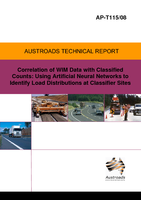Asset Management

Correlation of WIM Data with Classified Counts: Using Artificial Neural Networks to Identify Load Distribution at Classifier Sites
- Publication no: AP-T115-08
- ISBN: 978-1-921329-96-8
- Published: 16 October 2008
- PDF (free) Download
This report aims to ascertain the validity of the use of artificial intelligence (AI) to forecast gross combination mass (GCM) values by the correlation of WIM data with classified counts. AI has been applied successfully to speech recognition, image analysis and adaptive control for the construction of software agents (in computer and video games) or autonomous robots. This report describes a model using artificial neural networks (ANN) for forecasting GCM distribution for a particular site with a minimum set of input data from a low cost WIM system such as the piezoelectric cable, or where WIM data is not available. The validation results were not encouraging. The best R2 comparing observed and predicted GCMs was 0.59 with outliers discarded (and was 0.15 with outliers included). Despite many attempts at different implementations of the method, the predictive capability was generally poor. Two possible reasons are the complexity of the relationship between various input parameters and the desired output (GCM distribution), and the limited number of data points on which to base training and testing. It is considered that the framework used for developing the prediction is robust. This framework can accommodate a variety of predictive algorithms (ANNs were used in this case). It is possible that other predictive algorithms may be more successful. However, ultimately, the above constraints (complexity and limited data) are expected to prevail. Two areas are recommended for further research - the detailed analysis of causal factors in the ANN framework influencing load distribution at two to three WIM sites and the homogeneousness of data from WIM sites between states
- 1. INTRODUCTION
- 2. METHODOLOGY
- 2.1. Load Profiles
- 2.1.1. Distinction between Load Profiles and Variation in their Means
- 2.1.2. Calculation of the Mean ESA
- 2.2. ANN for Forecasting
- 2.3. Values of Inputs
- 2.4. Data Sources
- Road access type
- 3. THE ANN MODELS
- 3.1. Design
- 3.2. Performance Metrics
- 3.3. Model Calibration
- 4. VALIDATION RESULTS
- 4.1. Initial Validation Results
- 4.2. A Complex Task
- 4.3. Further Analysis - Predicting Means Rather than Distributions
- 5. CONCLUSIONS AND RECOMMENDATIONS
- REFERENCES
Related publications
WEB-GADA-24
WEB-R695-G104-2-23
Latest Asset Management News
